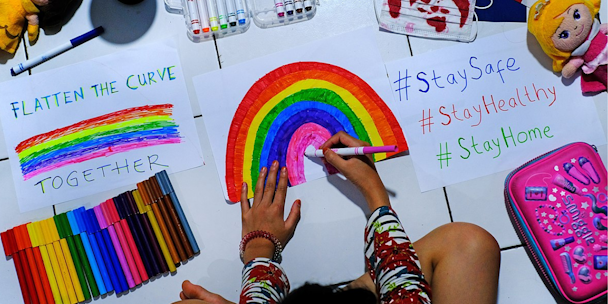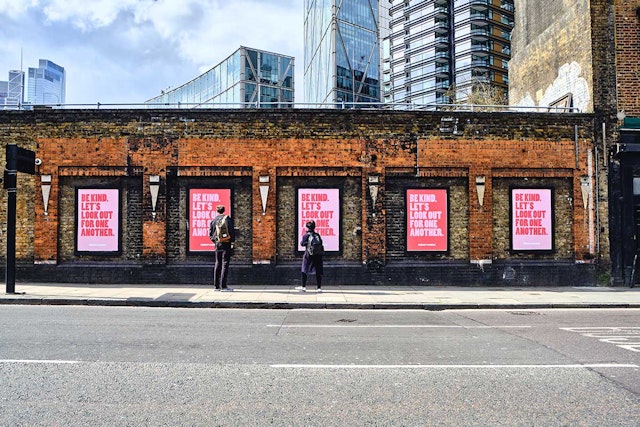
Advertisement

How are agencies bracing for what could be the toughest few months of the crisis yet?
It may only be January, but sustained cuts to ad spend are already pointing to a tough and unpredictable 2021 for the UK ad industry. There are, thankfully, lessons to be taken from the first two lockdowns, which should stand agencies in good stead as they navigate the third and hopefully final instalment of a truly miserable trilogy. Here is our guide to surviving lockdown 3.0.
For UK consumers, January is a month typically marked by weight loss ads, New Year resolutions and a budget holiday marketing blitz. This year, however, things are rather different, with billboards, TV and websites carrying instead the very direct message: ‘Stay At Home’.
Yes, almost a year on since the pandemic reared its head, our island finds itself once more in the midst of a Covid-19 lockdown. The toughest since last March, in fact.
Along with increased pressure to prove their value, enforced staff cuts and physical barriers to creativity, marketers can add the latest restrictions on movement to their growing list of concerns – yet another headache for agencies.
Even before the latest lockdown, sustained limitations in the UK continued to weigh heavily on brand budgets. Numbers published by the Institute of Practitioners in Advertising (IPA) last week showed that 40.4% of firms experienced a decline in marketing budgets in the final quarter of 2020 (typically a strong season thanks to the Christmas advertising boom), compared with just 16.4% that noted an increase in available funds – a net balance of -24.0%.
After four consecutive quarters of cuts, marketers are echoing consumer sentiments of macro gloom in the short-term. However, with a vaccine and an economic recovery on the horizon, they’re also feeling more positive about the upcoming prospects for their own company and that latest net figure of -24.0% is more moderate than in Q2 (-50.7%) and Q3 (-41.0%) last year. The coming financial year is also looking brighter, with a net balance of +12% of senior brand bosses expecting total marketing budgets to be revised upwards.
Figures from the latest Advertising Association (AA)/WARC Expenditure Report forecast slower growth in 2021 than previously expected, with the 14.4% of gains slated for 2021 unlikely to offset last year’s losses. This means the UK’s ad market is not expected to fully recover until 2022.
That’s the bigger picture. But what about the short to medium-term outlook? How are agencies bracing for what could be the toughest few months of the crisis yet and have the lessons learned in lockdowns one and two prepared them to lead clients on the road to recovery?
Clare Lawson, chief customer officer at Ogilvy UK, says she isn’t so much witnessing a pull back to ad spend, but more a change in spending patterns as well as a leap towards a “performance and precision” mindset from clients. In response, the agency is developing more long-term programmes than pure advertising campaigns, focused on both branding and sales.
Natalie Graeme, a co-founder of Uncommon Creative Studio (the agency that emerged from the ashes of Grey’s leadership team in 2016), agrees and says the industry isn’t seeing the kneejerk “needs must” slashes to spend that the first lockdown wrought.
“The main mode for brands planning ahead for 2021 seems to be a balance of savvy spending in the moment coupled with cautious optimism to continue to invest in brand building for the longer term,” she observes.
As soon as Covid-19 hit, Uncommon rapidly began re-planning “every single bit of activity” for every brands by asking how it could help brands for the now, during the crisis and post-pandemic.
“These three pillars continue to play a huge part in how we’re partnering with clients this time around. The brands coming through this crisis strongest are, by in large those who have been able to adapt at speed to the constantly changing situation, while also staying firmly in touch with the mood of the nation and, in many instances, fundamentally reposition the way their brand is seen by consumers.”
Though no one can predict the future, her advice to other agencies weathering this economic storm is to be clear in their role as a partner to brands, delivering strategies that will help them emerge from this period with clarity of their purpose and ready for what’s next.
Leo Burnett chief executive Charlie Rudd, who counts McDonald’s among his clients, says that lockdown 3 feels like “less of a crisis from a work and delivery standpoint” for brands and agencies alike.
“Lockdown one felt like crisis mode and while lockdown three is obviously not great news, we have in place behaviours, systems and processes that mean our clients are able to approach this time with a measured and confident response, rather than imagining the worst,” he explains.
A big focus for his leadership team just now is helping clients deliver messages with “empathy, confidence and clarity”.
Keeping staff motivated and in a good place professionally and personally to service the roster is a priority too. “Lockdown three is the one we didn’t think we’d have. Everyone was ready to return to normal, get back the office and forget about 2020 entirely,” he says.
“The rug being pulled from under us in that respect – and, let’s face it, the gloomy weather – means that it’s not enough to do more of the same with our teams and clients as we did the last two times around, because people are feeling more frustrated, more isolated, more impacted by it than ever.
“There is a heightened psychological impact, and it’s so important we as a business are sensitive to that when working with the people we serve – whether that’s within the agency or our clients.”
While the advertising industry is, of course, sensitive to the economy and consumer sentiment, Rudd advises other agency leaders to focus on what they can impact and control, instead of what they can’t.
“What you do and how your people feel, the quality of your work and how you operate as a business, is much more likely to affect your financial performance than the economy is.”

Dan Cullen-Shute, founder and chief executive of indie agency Creature, is candid in his admission that some clients are indeed tightening their belts, but says it varies immensely from sector to sector.
“Yes, some clients are definitely looking at rephrasing some of their spend, but most are continuing to operate in smart, pandemic-appropriate – which is a phrase I’d never even considered using a year ago – ways.”
His recommendation to fellow agency chief execs right now? Shut up and listen.
“While our industry went into a bit of a panic and started dusting off Binet & Field’s sage words on the power, value and importance of advertising through a pandemic, we took a breath,” he says of the first lockdown.
“Our instinct was that our clients’ focus wouldn’t immediately be on their brands, but rather on their jobs, their teams, and their families: sometimes, the art of partnership is knowing when to shut up and leave your partner alone. So, for the first couple of weeks of lockdown, that’s what we did: we let our clients know we were there when they needed us, and that we wouldn’t bother them until they did.”
For some clients, that point came quickly, but for others it took a little longer.
What Creature has done since then is bake flexibility into its structure, with the view that being genuine partner to clients instead of simply a creative shop means they’ll never stop needing you “just because their shops are closed, or their TV budget’s been pushed back into Q3“.
“Overall, though, our view is that lockdown 3.0 is an altogether much more positive experience from a commercial point of view: things haven’t ground to a halt the way they did in March of last year,“ he adds.
As we gaze into 2021, it’s clear the role of agency partners will be to help clients continue to make the shift from campaign-based marketing towards long-term brand building. They’ll also need to ensure they’re focused on building strategies that work for a post-Covid era (whenever that may dawn) and becoming indispensable partners instead of suppliers.
A focus on their own people and structure will also be required, and CEOs shouldn’t let the bigger picture cloud their judgement on what’s happening internally.
Kirsty Giordani, executive director for the UK at the International Advertising Association (IAA), says that with the Brexit deal uncertainty of 2020 behind them and a vaccine rollout ahead, agencies should use this time to start helping marketers tentatively plan for recovery.
Jenny Kirby, managing partners at WPP media powerhouse GroupM, weighs in to say that while continued restrictions in the UK clearly weighed heavily on overall ad spending in the final quarter of 2020, it’s important to note the bright spots: like the fact digital advertising grew by 0.7% in Q4 2020, compared to falling 6.5% in Q3 2020, standing in stark contrast to other sectors such as OOH and events, which took a serious hit.
Kantar’s global head of media, Jen Ostler, highlights its recent Business Compass research, which reveals almost two-thirds (61%) of companies reduced their marketing spend in 2020, with the average decrease being 37%.
Half of the firms surveyed said they had cut communications and media spend, by an average of 39%.
Now, Kantar’s Media Reactions research shows that in 2021 advertisers anticipate net positive increases in ad spend on online video, social media, display, influencer content, streaming, podcasts, TV, sponsorship and DOOH.
That’s because this time around they now have their lockdown strategies nailed down. This means the impact will be less severe for agencies in the second half of the year, since brands and media owners understand the need for flexibility in media planning should channels be restricted in availability or reach.
“If you haven’t been protecting yourself from dips in ad spend over the last five years, I don’t think you’ve been in the right game,” asserts Ogvily’s Lawson.
“Our analysis shows that, even pre-pandemic, spend was continually shifting from advertising to many other areas.
"We’ve seen exponential growth in our technology and experience business, our influence offering, our social performance arm, employee engagement and business growth and consultancy services,” she adds, giving at agencies a nudge to where they might look to next in order to offset that lockdown slump.
Additional reporting by Imogen Watson and John McCarthy.